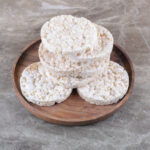
Table of Contents
Overview
Purple rice, often referred to as “forbidden rice,” is a type of rice that stands out due to its rich, dark purple color and exceptional nutritional profile. Traditionally consumed by Asian royalty, this ancient grain is now celebrated worldwide for its health benefits. In this blog post, we will explore what makes purple rice so special, its impressive nutritional value, the health benefits it offers, and how you can easily incorporate it into your diet.
What Is Purple Rice?
Purple rice is a unique variety of rice known for its deep purple color, which comes from anthocyanins—powerful antioxidants also found in foods like blueberries and blackberries. Unlike white or brown rice, purple rice is packed with more nutrients, making it not only a visually appealing choice but also a nutritionally superior one. Historically, purple rice was highly valued and often reserved for royalty in China, earning it the nickname “forbidden rice.”
Nutritional of Purple Rice
Purple rice is much more than just a colorful grain. It is packed with essential nutrients that contribute to overall health:
- High in Antioxidants: The anthocyanins in purple rice are potent antioxidants that help neutralize free radicals in the body, protecting against oxidative stress and reducing the risk of chronic diseases such as heart disease and cancer.
- Rich in Fiber: Purple rice is an excellent source of dietary fiber, which supports healthy digestion, promotes regular bowel movements, and helps in weight management by keeping you fuller for longer.
- Vitamins and Minerals: This variety of rice is rich in essential vitamins and minerals like vitamin E, iron, and zinc, which are crucial for maintaining healthy skin, boosting the immune system, and improving overall bodily functions.
- Low Glycemic Index: With a lower glycemic index compared to white rice, purple rice is a better option for managing blood sugar levels, making it an ideal choice for people with diabetes or those looking to maintain steady energy levels.
Health Benefits of Purple Rice
Incorporating purple rice into your daily diet can provide a range of health benefits:
- Supports Heart Health: The anthocyanins found in purple rice have anti-inflammatory properties that help reduce the risk of heart disease by lowering bad cholesterol levels and improving heart function.
- Fights Against Cancer: Studies suggest that the antioxidants in purple rice may inhibit the growth of cancer cells, particularly in the colon and liver, offering potential protective effects against cancer.
- Aids in Weight Management: The high fiber content in purple rice helps control appetite by promoting a feeling of fullness, which can lead to reduced calorie intake and support weight loss efforts.
- Promotes Digestive Health: The fiber in purple rice aids in digestion by promoting regular bowel movements and maintaining a healthy gut microbiome, which is essential for overall digestive health.
- Protects Eye Health: The presence of vitamin E and other antioxidants in purple rice helps protect the eyes from oxidative stress, reducing the risk of age-related eye conditions
Related Are Rice Cakes Healthy Benefits Risks
How to Incorporate Purple Rice into Your Diet
Purple rice is versatile and can be used in a variety of dishes, both savory and sweet. Here are some simple ways to include it in your meals:
- Rice Bowls: Use purple rice as a base for nourishing rice bowls topped with fresh vegetables, lean proteins, and a flavorful dressing.
- Salads: Add cooked purple rice to salads for an extra boost of nutrients and a pop of color.
- Side Dishes: Serve purple rice as a side dish seasoned with your favorite herbs and spices, or mix it with other grains for a nutrient-rich blend.
- Desserts: In many Asian cultures, purple rice is used in desserts such as rice pudding or sweet coconut rice. Try it in your favorite rice-based dessert recipe for a unique twist.
The Takeaway
Purple rice is more than just an exotic ingredient; it’s a superfood that offers numerous health benefits. From supporting heart health to aiding in weight management, this ancient grain is a valuable addition to any diet. Whether you’re looking to diversify your meals or boost your nutrient intake, purple rice is a delicious and nutritious option worth exploring. So, why not give it a try and enjoy the myriad benefits this “forbidden rice” has to offer?
Frequently Asked Questions
What makes purple rice different from other types of rice?
Purple rice is unique because of its deep purple color, which comes from anthocyanins—antioxidants also found in berries. It’s more nutritious than white or brown rice, offering higher levels of fiber, vitamins, and antioxidants.
Is purple rice good for people with diabetes?
Yes, purple rice has a lower glycemic index compared to white rice, which means it helps manage blood sugar levels more effectively, making it a better choice for people with diabetes.
How can I cook and use purple rice in my meals?
You can cook purple rice similarly to other types of rice by boiling or steaming. It can be used as a base for rice bowls, added to salads, served as a side dish, or even used in desserts like rice pudding.











